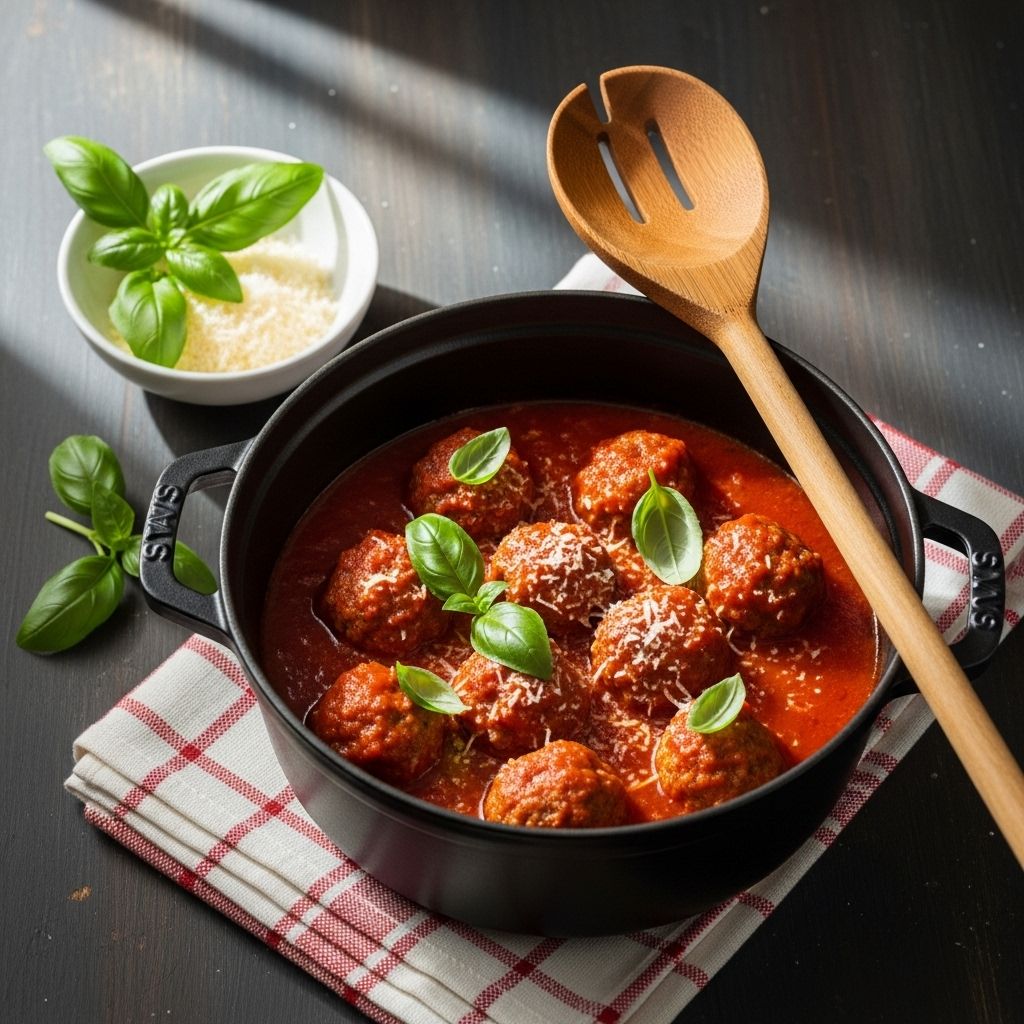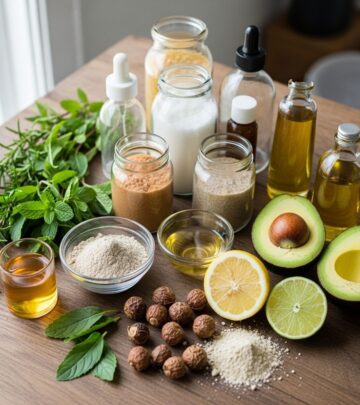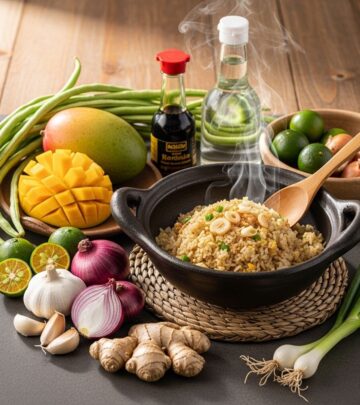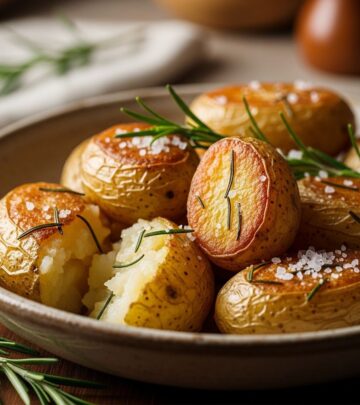Italian Meatball Recipe: 5 Easy Steps For Authentic Flavor
Unlock rich flavors and timeless traditions with this ultimate guide to savory delights.

Image: HearthJunction Design Team
The Best Meatballs: An Authentic Italian Recipe Guide
If you’ve been searching for the ultimate meatball recipe, your quest is over. This comprehensive guide shares all the secrets to making classic Italian meatballs that are tender, juicy, and bursting with robust flavor. From choosing the right combination of meats to mastering the perfect texture, this article covers every detail for home cooks of all skill levels. Read on to learn about core ingredients, preparation techniques, cooking tips, serving ideas, and answers to your most common meatball questions.
Ingredients for the Best Meatballs
The foundation of exceptional meatballs is a thoughtfully selected blend of ingredients, each adding its own depth of flavor and texture. Here’s what you’ll need for authentically delicious Italian meatballs:
- Ground Meat: The best meatballs use a mixture of ground beef, ground veal, and ground pork. This trio delivers a perfect balance of rich flavor and tenderness. If you don’t have all three, substituting with just beef and pork, or even just beef, still yields delicious results.
Standard ratio:- 1 pound ground beef
- 1/2 pound ground veal
- 1/2 pound ground pork
- Romano Cheese: Freshly grated Romano cheese is preferred for robust, tangy notes. Parmesan can be used as a substitute, but avoid pre-grated cheese for the best results.
- Eggs: Eggs serve as a binding agent, helping the meatballs hold together and retain moisture.
- Fresh Garlic: Adds aromatic depth and traditional Italian flavor.
- Fresh Italian Parsley: Incorporates bright herbal notes and color.
- Black Pepper and Salt: Essential for boosting and balancing flavors.
- Stale Italian Bread: Slightly stale bread, soaked in water or milk, is crumbled and added to the meat mixture. This technique ensures the meatballs remain tender and moist.
- Water: Slowly incorporated into the mix, water (or sometimes milk) creates a uniquely soft, moist texture prized in Italian meatballs.
- Olive Oil: For frying the meatballs until they’re crisp and brown on the outside.
Ingredient Table for Classic Italian Meatballs
| Ingredient | Amount | Notes |
|---|---|---|
| Ground Beef | 1 lb | Can replace veal/pork if needed |
| Ground Veal | 1/2 lb | Optional, adds tenderness |
| Ground Pork | 1/2 lb | Optional, adds fat & flavor |
| Romano Cheese (freshly grated) | 1 cup | Or Parmesan |
| Eggs | 2 large | Beaten |
| Garlic | 2 cloves | Minced |
| Italian Parsley | 2 tbsp | Chopped |
| Salt & Black Pepper | To taste | Freshly ground |
| Stale Italian Bread | 2 cups | Crusted, soaked & crumbled |
| Water | 1 cup | Or milk |
| Olive Oil | For frying | Extra virgin preferred |
Step-by-Step: How to Make Authentic Italian Meatballs
While making meatballs is straightforward, attention to detail ensures the final result is moist, flavorful, and never dry or tough. Follow these key steps for perfect meatballs every time:
1. Prepare the Bread
- Break stale Italian bread into large pieces. Place them in a bowl and add enough water (or milk) to cover. Let soak for a few minutes until soft.
- Squeeze out excess liquid and crumble the bread finely. This soft bread will lend a unique tenderness to your meatballs.
2. Combine Meats and Seasonings
- In a large mixing bowl, combine the ground beef, veal, and pork.
- Add crumbled soaked bread, eggs, minced garlic, chopped parsley, grated Romano cheese, salt, and black pepper.
- Mix gently by hand until just combined. Overmixing can make meatballs tough.
3. Add Water for Moisture
- Slowly add up to 1 cup of water (or milk), mixing gently until the mixture becomes soft and slightly sticky. This step is crucial for moist, tender meatballs.
4. Form the Meatballs
- Using damp hands, shape the mixture into balls approximately 1 1/2 inches in diameter for classic Italian meatballs. For even sizing, use an ice cream scoop.
5. Fry the Meatballs
- Heat olive oil in a large skillet over medium-high heat.
- Fry the meatballs in batches, turning occasionally, until they are browned on all sides and cooked through, roughly 10-15 minutes in total.
- Transfer cooked meatballs to a paper towel-lined plate to drain excess oil.
Tips for Extra-Tender, Flavorful Meatballs
- Don’t Skip the Bread: The bread and its liquid are essential for texture. Unlike bread crumbs, well-soaked bread yields moist, fluffy meatballs.
- Use a Gentle Touch: Overmixing can lead to dense, tough meatballs. Mix the ingredients gently, just until incorporated.
- Cook in Batches: Avoid overcrowding the pan. Fry meatballs in batches so they brown evenly and maintain their shape.
- Try Baking for Less Mess: If you prefer, meatballs can be baked in a 350°F (175°C) oven for about 30 minutes, turning once halfway through, until cooked through and browned.
- Finish in Sauce: For added flavor and moisture, simmer browned meatballs in tomato sauce for 15-20 minutes before serving.
Meatball Variations
While the classic recipe is unbeatable, there’s ample room to experiment. Here are a few variations to suit different tastes and dietary needs:
- All-Beef Meatballs: Substitute ground pork and veal with more ground beef if preferred.
- Cheese Substitutions: If Romano cheese is unavailable, use Parmesan or Grana Padano.
- Baked Meatballs: Bake meatballs instead of frying for a lighter alternative and easier cleanup.
- Gluten-Free Meatballs: Use gluten-free bread or breadcrumbs in place of traditional Italian bread.
- Vegetable-Infused: Finely grated onion, carrot, or zucchini can be added to the mixture for subtle sweetness and moisture.
Serving Suggestions and Pairings
Italian meatballs are remarkably versatile. Enjoy them in any of the following ways:
- With Marinara Sauce: Simmer meatballs in homemade or high-quality jarred marinara sauce and serve over pasta for a timeless comfort meal.
- Meatball Subs: Serve meatballs on toasted Italian rolls with melted provolone or mozzarella for a hearty sandwich.
- Appetizer Style: Plate meatballs on toothpicks, sprinkled with extra Romano cheese and parsley for elegant starters.
- With Polenta or Rice: Serve over creamy polenta or fluffy rice for a rustic Italian twist.
- As a Main Dish: Pair with a crisp Italian salad and garlic bread for a complete meal.
Storing and Reheating Meatballs
Meatballs store beautifully, making them perfect for meal prep and leftovers.
- Refrigerator: Store cooked meatballs in an airtight container for up to 4 days.
- Freezer: Freeze cooled meatballs (with or without sauce) in a single layer before transferring to a freezer bag for up to 3 months. Thaw overnight in the fridge.
- Reheating: Warm in simmering sauce or in a covered dish in the oven at 300°F (150°C) until heated through.
Frequently Asked Questions (FAQs)
Q: Can I use only one type of ground meat?
A: Yes. While the blend of beef, pork, and veal produces a richer flavor, using just one meat—such as all beef—still makes delicious meatballs. For moisture and tenderness, consider increasing the amount of soaked bread.
Q: What’s the secret to super moist meatballs?
A: The combination of soaked stale bread and gently mixing in water (or milk) is key to ultra-moist meatballs. Avoid overworking the mixture, and don’t skip the added liquid, which keeps the interior soft and juicy.
Q: Should I bake or fry meatballs?
A: Both methods work well. Frying yields a crisp, flavorful exterior, while baking is less messy and a bit lighter. You can bake meatballs at 350°F (175°C) for 25-30 minutes or until browned and cooked through, turning once for even color.
Q: Can I make meatballs ahead of time?
A: Absolutely. Prepare and shape the meatballs up to a day in advance. Store covered in the refrigerator. Cooked meatballs can also be refrigerated for 3-4 days or frozen for up to 3 months.
Q: How do I keep meatballs from falling apart?
A: Using eggs and soaked bread helps hold the mixture together without making it dense. Handle the mixture gently, and don’t pack the meatballs too tightly when shaping.
Q: Can I make meatballs without cheese?
A: Cheese adds flavor and richness, but you can omit it for dairy-free or lighter meatballs. Add extra herbs or a tablespoon of nutritional yeast to boost the savory notes.
Expert Tips for Perfect Meatballs Every Time
- Use Day-Old Bread: Fresh bread can become gummy when soaked; slightly stale bread holds up better and soaks up more liquid, resulting in a lighter texture.
- Test a Small Amount: Fry a tiny portion of the meat mixture and taste for seasoning before shaping all the meatballs. Adjust salt, pepper, or cheese as needed.
- Uniform Size: Make sure all meatballs are roughly the same size to ensure even cooking.
- Resting Time: If possible, refrigerate the formed meatballs for 30 minutes before cooking. This helps them firm up and maintain their shape during frying or baking.
Nutritional Insights
Meatballs are a protein-rich food. Using a mix of beef, pork, and veal offers a balance of healthy fats and proteins. You can lighten the recipe by using leaner meats or baking instead of frying. For a lower-sodium meal, use less cheese and salt, and prioritize fresh over processed ingredients.
Conclusion
Making authentic Italian meatballs from scratch is both satisfying and rewarding. Whether you’re cooking for family, friends, or a special occasion, this recipe ensures you serve perfectly seasoned, juicy, and tender meatballs every time. Don’t hesitate to personalize the recipe with your favorite ingredients or serve it in creative ways. With these tips and techniques at your fingertips, you’ll never settle for bland, dry meatballs again—only flavorful, homemade classics worthy of the Italian tradition.
References
- https://www.allrecipes.com/recipe/40399/the-best-meatballs/
- https://www.allrecipes.com/recipe/72595/the-best-meatballs-youll-ever-have/
- https://www.allrecipes.com/recipe/213742/meatball-nirvana/
- https://www.allrecipes.com/recipe/220854/chef-johns-italian-meatballs/
- https://www.allrecipes.com/recipe/268249/italian-baked-meatballs/
Read full bio of medha deb












